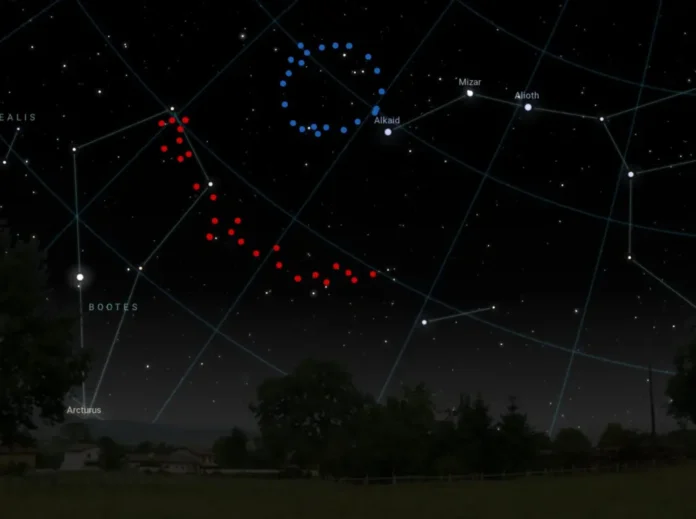In a groundbreaking revelation that challenges our fundamental understanding of the cosmos, astronomers have discovered a colossal structure in the distant universe that raises profound questions about the evolution of the universe. Dubbed the Big Ring, this nearly perfect ring of galaxies spans an astonishing 1.3 billion light-years in diameter and appears to defy conventional models of cosmic structure and formation mechanisms.
This remarkable discovery is the result of astronomical observations made possible by light that has traveled an impressive 6.9 billion years to reach Earth. The findings were spearheaded by Alexia Lopez, an astronomer from the University of Central Lancashire, and presented at the 243rd meeting of the American Astronomical Society in January. The research was subsequently published in the Journal of Cosmology and Astroparticle Physics, marking a significant milestone in our quest to understand the universe’s architecture.
A Deeper Mystery
The Big Ring is not an isolated find; it is the second giant structure uncovered by Lopez and her team. The first, known as the Giant Arc, resides in the same region of the sky and at a similar distance. When the Giant Arc was revealed in 2021, it bewildered astronomers and opened up a new frontier of inquiry into cosmic structures. The identification of the Big Ring only deepens the enigma surrounding these ultra-large formations.
Lopez remarked, “Neither of these two ultra-large structures is easy to explain in our current understanding of the universe.” She emphasized that their immense sizes, unique shapes, and proximity on a cosmological scale suggest they could hold vital clues about the universe’s formation and evolution. However, the precise implications of these structures remain elusive.
Understanding Baryon Acoustic Oscillations
One immediate connection researchers are exploring is with Baryon Acoustic Oscillations (BAO). BAOs are vast circular arrangements of galaxies scattered throughout the universe, which act as remnants of sound waves from the early universe. These oscillations occurred when sound waves traveled through the primordial hot plasma of the cosmos, leaving imprints in the distribution of galaxies once the universe cooled and became transparent.
However, it is crucial to clarify that the Big Ring does not fit into the BAO category. BAOs are generally uniform in size, approximately 1 billion light-years in diameter. In contrast, a detailed analysis of the Big Ring reveals it exhibits a corkscrew shape, which, when viewed from certain angles, appears as a ring. This discrepancy raises further questions about its nature and classification.
Implications for the Cosmological Principle
The discovery of the Big Ring poses significant questions regarding the Cosmological Principle, which asserts that the universe should appear homogeneous and isotropic on a large scale. In simpler terms, this principle suggests that any large region of space should look similar to any other large region. Lopez elucidated this idea, stating, “We expect matter to be evenly distributed everywhere in space when we view the universe on a large scale, so there should be no noticeable irregularities above a certain size.”
Currently, cosmologists estimate that structures larger than 1.2 billion light-years should not exist. Yet, both the Giant Arc and the Big Ring far exceed this theoretical limit, with the Giant Arc being nearly three times larger and the Big Ring’s circumference comparable to the Giant Arc’s length. The implications of such enormous structures challenge the validity of the existing cosmological framework.
A Challenge to Current Cosmological Models
Beyond their impressive size, these discoveries also pose a significant challenge to the field of cosmology, which seeks to understand the universe’s evolution. The standard cosmological model has been widely accepted due to its consistency with observational data. However, the emergence of the Big Ring and the Giant Arc introduces features that are difficult to explain within this framework.
To address these inconsistencies, alternative models of cosmology have been proposed. One such model is Roger Penrose’s Conformal Cyclic Cosmology, which posits that the universe undergoes endless cycles of expansion and contraction. Within this framework, the existence of ring-like structures is expected. However, it is important to note that conformal cyclic cosmology also has its own set of challenges and criticisms.
Conclusion
The discovery of the Big Ring is a remarkable advancement in our understanding of the universe, compelling astronomers and cosmologists alike to reevaluate existing theories about cosmic structure and formation. As researchers continue to investigate these colossal structures, they may uncover new insights that could reshape our comprehension of the cosmos.
As the scientific community grapples with the implications of the Big Ring, the quest for knowledge about the universe continues. This monumental find could pave the way for groundbreaking developments in cosmology, potentially leading us closer to answering some of the most profound questions about the nature of reality and our place within the vast expanse of the universe. The ongoing research surrounding the Big Ring promises to deepen our understanding of the cosmos and inspire future generations of scientists in their exploration of the universe’s mysteries.


